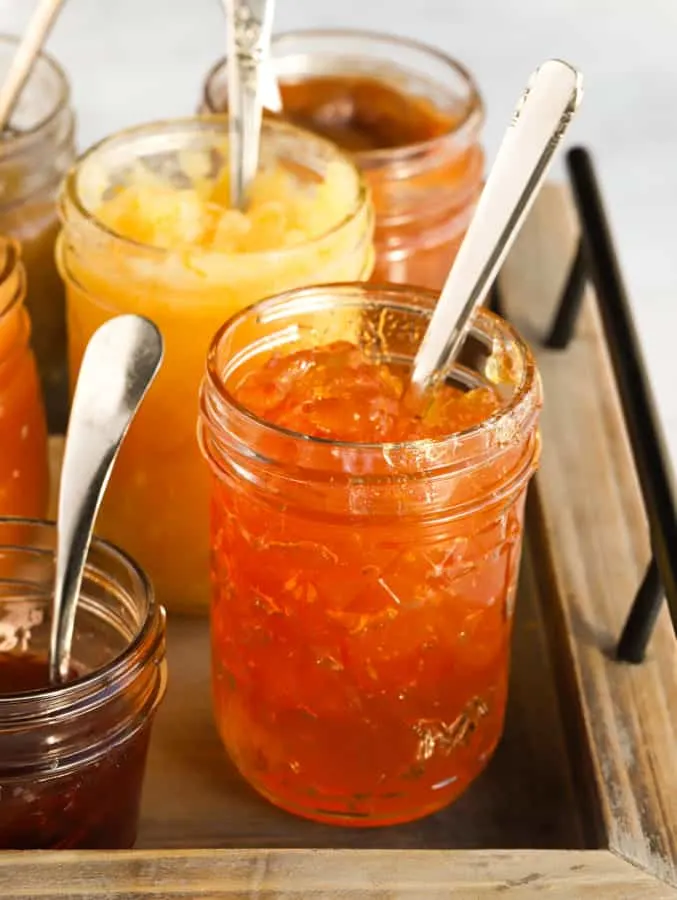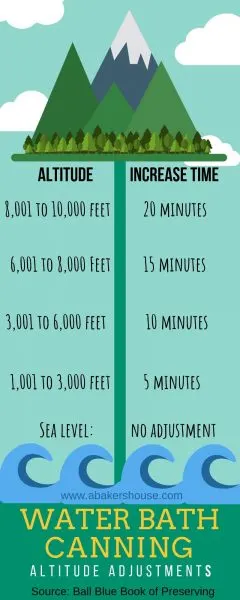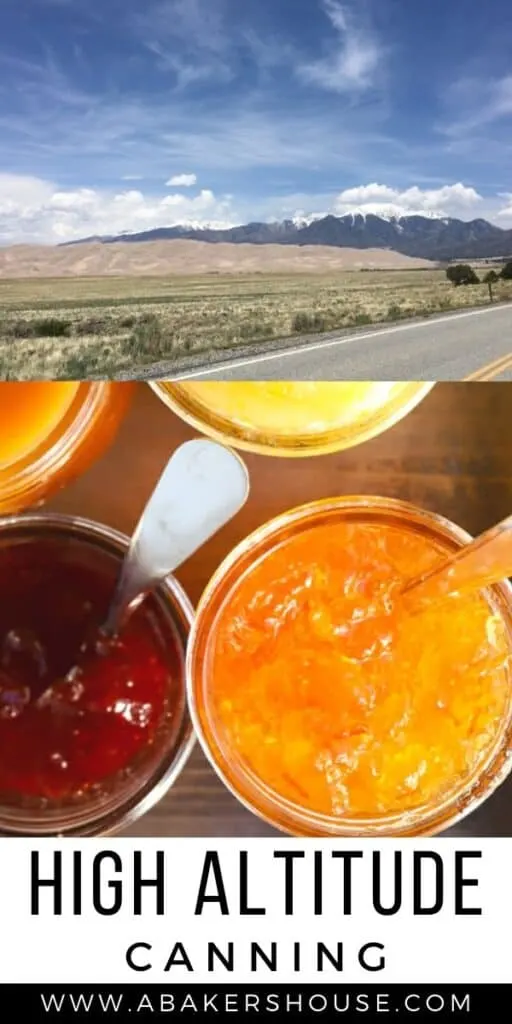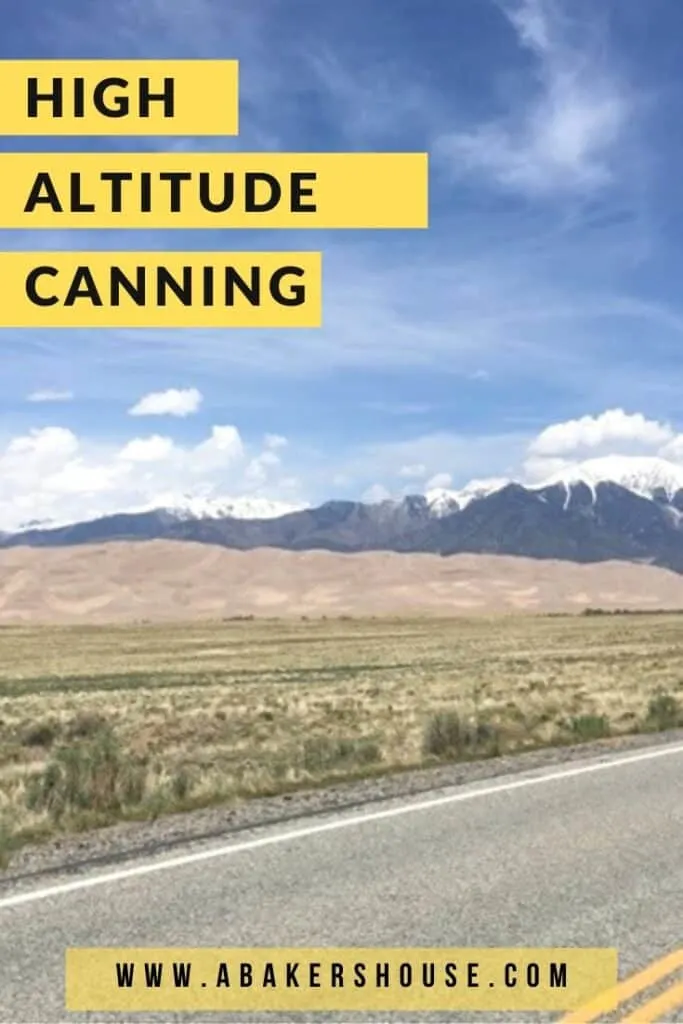This is a guide to high altitude canning. Did you know that your elevation affects the process of canning preserves? You may need to adjust your processing time when using boiling water bath canning and the amount of pressure when using pressure canning.

Whether you are a seasoned expert or a new beginner, learning how to make jam requires that you follow a set of scientific rules to ensure that your jams, jellies, marmalade, and more follow food safety guidelines. One of those guidelines for food safety in jams includes making adjustments for high altitude.
What changes at high altitude?
If you’ve ever traveled to high altitude (above 3000 feet), you may have noticed that you were short of breath more easily or that you didn’t feel quite the same.
Scientifically speaking, the air is thinner at higher altitudes and there is less oxygen. Read more in depth about the effect of the change in atmosphere on this High Altitude site.
How does this change the results of baking or canning?
Breads and cakes bake differently at higher elevations. Cakes might rise quickly then deflate rapidly as they cool.
Water boils at a lower temperature as you depart from sea level. When we use a water bath canner for preserving jams and jellies, we are trying to get rid of anything that might encourage the mason jar’s contents to spoil. Lower temperatures are less effective at killing harmful organisms so if your pot of water is boiling at a lower temperature when you are at a higher altitude, you must boil your jars for a longer period of time to make up for the lack of higher boiling temperature.
The general rule of thumb for water bath canning is to increase the processing time for your jam recipe if you are above 1000. See the table in the section below for specific time adjustments.
If you are using a pressure canner to preserve lower acid fruits and vegetables (like tomatoes or green beans), then you will need to keep the time the same and increase the amount of pressure. See below for pressure adjustments by altitude.

Water bath canning adjustments
Water bath canners are used for high acid foods and most likely is what you’ll use to can jams, jellies and marmalades.
The times listed in the canning cheat sheet below are IN ADDITION to the original processing time in a canning recipe. Add the amount of time to your processing time depending on your elevation.

Pressure canner adjustments
Pressure canners are used on low acid foods like tomatoes, vegetables and meats.
For a pressure canner keep the processing time the same but increase the pressure according to this table below.
| Pressure Canning Adjustment Chart for Low Acid Foods | ||
| Altitude (feet) | Weighted Gauge (lb) | Dial Gauge (lb) |
| 0 to 1,000 | 10 | 11 |
| 1,001 to 2,000 | 15 | 11 |
| 2,001 to 4,000 | 15 | 12 |
| 4,001 to 6,000 | 15 | 13 |
| 6,001 to 8,000 | 15 | 14 |
| 8,001 to 10,000 | 15 | 15 |
| Source: Ball Complete Book of Home Preserving, page 382 |
What is my elevation?
Elevation is how many feet or meters you are above sea level. This data point may not be something you think of on a daily basis but your altitude affects the ease of breathing, how certain foods bake, and, as we are discussing here, how to process jam when canning and preserving.
You may have a rough idea of your elevation already. For example, Denver is known as the mile-high city so I know that here in Colorado I am about one mile or 5,280 feet above sea level.
If you live along a coast your elevation is generally even more obvious– you are at sea level and 0 feet elevation.
I’ve lived at a variety of altitudes from the beaches of Bermuda and Hawaii to the mountains of Colorado. What about you? Have you found differences in baking and canning (and ease of breathing) in locations that you’ve called home or visited?
Here are elevations of various cities in the U.S.
| City |
Altitude in Feet Above Sea Level | Adjustment needed? |
| Dover, Delaware | 30 | no |
| Philadelphia, PA | 39 | no |
| Trenton, NJ | 49 | no |
| San Francisco, CA | 52 | no |
| Portland, Maine | 62 | no |
| Orlando, FL | 82 | no |
| Houston, TX | 105 | no |
| Boston, Massachusetts | 141 | no |
| Memphis, TN | 338 | no |
| Atlanta, Georgia | 1026 | yes |
| Topeka, Kansas | 1078 | yes |
| Phoenix, Arizona | 1135 | yes |
| Omaha, Nebraska | 1325 | yes |
| Las Vegas, Nevada | 2181 | yes |
| Tucson, Arizona | 2643 | yes |
| Boise, Idaho | 2871 | yes |
| Billings, Montana | 3652 | yes |
| Denver, Colorado | 5280 | yes |
| Cheyenne, Wyoming | 6063 | yes |
| Santa Fe, New Mexico | 6348 | yes |
| Aspen, Colorado | 7820 | yes |
If your city is not listed in this table (or if you would like a more accurate measurement), there are two websites that quickly and easily report your altitude.
There are also apps that report your altitude. Google Maps does this as well as the apps called My Altitude and Current Altitude.
More info about high altitude adjustments
Are you looking for more info about what changes are necessary for food safety at high altitude? The United States Department of Agriculture (USDA) has information that is really helpful on the USDA website.
There are some topics I had never considered such as changes when microwaving at altitude or using a slow cooker at altitude.
More info on preserving
Now that you know about the adjustments to make at higher elevations, you are ready to dive into preserving foods with home canning. Here are valuable topics that may help you along the way.

Holly Baker started the food blog, A Baker’s House, in 2011. She is the writer, recipe creator, and photographer for the site. Holly loves to bake and shares recipes for gluten free food, canning recipes, as well as traditional desserts too. Her recipes and food photography have been highlighted by BuzzFeed, Reader’s Digest, and She Knows.



Catherine Kushner
Saturday 9th of July 2022
I live in the Southlands area of East Aurora, Co., my elevation is at 5900. I increase the time of my water bath canning for an additional 10 min. I worry that the extra time plus a 5 min. wait time in the hot water after processing is causing my foods to be overcooked; for ex: pickles and my jams seem to be a bit loose, even with pectin.
I cannot find any information regarding this and wonder if this has been your experience as a high-altitude canner? Any advise would be appreciated.
Pamalla Mecham
Thursday 3rd of September 2020
Thank you for this information, I was double checking my knowledge.
Holly Baker
Friday 4th of September 2020
I'm glad to hear it helped.
Vboyer
Wednesday 8th of July 2020
Great info. Can you peel the plums. Not sure if I would Like the peel when eating the plum jam.
Holly Baker
Wednesday 8th of July 2020
You could peel the plums but it might affect how the jam gels-- the peel contains some pectin. The peel is not noticeable in the jam. It cooks down and breaks apart. If you do give peeling a try, let me know how it turns out. I am curious to know how much the pectin in the peel affects the finished product. Thanks for your comment!
Kankana Saxena
Wednesday 15th of January 2020
This is so informative! I had no idea the timing would change based on the altitude.
Holly Baker
Wednesday 15th of January 2020
Thanks for your comment! I think the science behind canning is really interesting too.